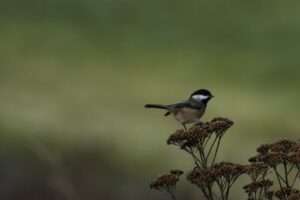 In winter, many of us enjoy welcoming resident or migratory birds to our yards and gardens with bird feeders. However, this season can also be a time to support the birds in another way: by planning to plant seed-producing, bug-attracting, locally native plants in our garden spaces come spring.
In winter, many of us enjoy welcoming resident or migratory birds to our yards and gardens with bird feeders. However, this season can also be a time to support the birds in another way: by planning to plant seed-producing, bug-attracting, locally native plants in our garden spaces come spring.
Trees and shrubs are important parts of a bird-friendly garden, for the nuts and berries they may produce, the insects they attract that become prey and the cover and nesting sites they can provide. Flowering perennials and annuals are just as crucial, however. Herbaceous plants with ample seed can offer birds a natural food source from summer into fall and winter. Their seed is particularly attractive to birds with small, sharp bills, such as chickadees, and those with hard, conical bills, like finches and juncos.
These plants also play important roles earlier, from spring into summer, when many native plants host insect larvae that feed on their leaves. These larvae can become food for birds, with adults consuming them and feeding them to their young, too.
Meanwhile these plants attract bees and butterflies to feed at their blossoms and pollinate the garden. Some wildflowers, like beebalm (Monarda), offer nectar to hummingbirds before going to seed.
Finally, these plants can delight our own senses, and when they are matched to the appropriate site they can mean less maintenance for the gardener to perform. In fact, when these plants are grown with the intent of aiding birds, typical seasonal maintenance should be eschewed. Cutting the plants and their seed heads back in the fall would defeat the purpose. Remaining material can be cut back in earliest spring, but don’t cart it away; leave trimmings in the garden and the birds can scavenge it for use in building their nests.
Choosing Plants
Although more and more cultivars of native species (or “nativars”) are entering the market each year, using the straight species is a surer bet for supporting insect larvae, pollinators and birds. Nativars have been bred and selected for certain traits, such as flower color and structure, bloom time and foliage color. Altering these characteristics may make the plant less recognizable or attractive to the wildlife that has evolved alongside it. And if the nativar has been rendered sterile to prolong bloom time, it will not produce seed.
www.hortmag.com/



